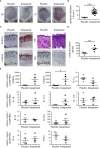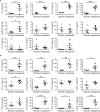Interleukin 17 Promotes Expression of Alarmins S100A8 and S100A9 During the Inflammatory Response of Keratinocytes
- PMID: 33643287
- PMCID: PMC7906991
- DOI: 10.3389/fimmu.2020.599947
Interleukin 17 Promotes Expression of Alarmins S100A8 and S100A9 During the Inflammatory Response of Keratinocytes
Abstract
Psoriasis is one of the most common immune-mediated inflammatory skin diseases. Expression and secretion of two pro-inflammatory molecules of the S100-alarmin family, S100A8 and S100A9, in keratinocytes is a hallmark of psoriasis, which is also characterized by an altered differentiation of keratinocytes. Dimers of S100A8/S100A9 (calprotectin) bind to Toll-like receptor 4 and induce an inflammatory response in target cells. Targeted deletion of S100A9 reduced the inflammatory phenotype of psoriasis-like inflammation in mice. A role of S100-alarmins in differentiation and activation of keratinocytes was suggested but has been never shown in primary keratinocytes. We now confirm that induction of S100-alarmins in an imiquimod-induced murine model of psoriasis-like skin inflammation was associated with an increased expression of interleukin (IL)-1α, IL-6, IL-17A, or TNFα. This association was confirmed in transcriptome data obtained from controls, lesional and non-lesional skin of psoriasis patients, and a down-regulation of S100-alarmin expression after IL-17 directed therapy. However, analyzing primary S100A9-/- keratinocytes we found that expression of S100A8/S100A9 has no significant role for the maturation and inflammatory response pattern of keratinocytes. Moreover, keratinocytes are no target cells for the pro-inflammatory effects of S100A8/S100A9. However, different cytokines, especially IL-17A and F, highly abundant in psoriasis, strongly induced expression of S100-alarmins preferentially during early maturation stages of keratinocytes. Our data indicate that expression of S100A8 and S100A9 does not primarily influence maturation or activation of keratinocytes but rather represents the inflammatory response of these cells during psoriasis.
Keywords: S100A8; MRP14; MRP8; S100A9; calprotectin; keratinocytes; myeloid-related proteins; psoriasis.
Copyright © 2021 Christmann, Zenker, Martens, Hübner, Loser, Vogl and Roth.
Conflict of interest statement
The authors declare that the research was conducted in the absence of any commercial or financial relationships that could be construed as a potential conflict of interest.
Figures







Similar articles
-
Autoinhibitory regulation of S100A8/S100A9 alarmin activity locally restricts sterile inflammation.J Clin Invest. 2018 May 1;128(5):1852-1866. doi: 10.1172/JCI89867. Epub 2018 Apr 3. J Clin Invest. 2018. PMID: 29611822 Free PMC article.
-
Deletion of S100a8 and S100a9 Enhances Skin Hyperplasia and Promotes the Th17 Response in Imiquimod-Induced Psoriasis.J Immunol. 2021 Feb 1;206(3):505-514. doi: 10.4049/jimmunol.2000087. Epub 2020 Dec 23. J Immunol. 2021. PMID: 33361205
-
S100A8 and S100A9 are messengers in the crosstalk between epidermis and dermis modulating a psoriatic milieu in human skin.Biochem Biophys Res Commun. 2012 Jul 13;423(4):647-53. doi: 10.1016/j.bbrc.2012.05.162. Epub 2012 Jun 7. Biochem Biophys Res Commun. 2012. PMID: 22683330
-
The endogenous Toll-like receptor 4 agonist S100A8/S100A9 (calprotectin) as innate amplifier of infection, autoimmunity, and cancer.J Leukoc Biol. 2009 Sep;86(3):557-66. doi: 10.1189/jlb.1008647. Epub 2009 May 18. J Leukoc Biol. 2009. PMID: 19451397 Review.
-
Inflammation-associated S100 proteins: new mechanisms that regulate function.Amino Acids. 2011 Oct;41(4):821-42. doi: 10.1007/s00726-010-0528-0. Epub 2010 Mar 6. Amino Acids. 2011. PMID: 20213444 Review.
Cited by
-
Reading of human acute immune dynamics in omicron SARS-CoV-2 breakthrough infection.Emerg Microbes Infect. 2025 Dec;14(1):2494705. doi: 10.1080/22221751.2025.2494705. Epub 2025 May 6. Emerg Microbes Infect. 2025. PMID: 40231451 Free PMC article.
-
A comprehensive characterization of metabolic signatures-hypoxia, glycolysis, and lactylation-in non-healing diabetic foot ulcers.Front Mol Biosci. 2025 Jul 9;12:1593390. doi: 10.3389/fmolb.2025.1593390. eCollection 2025. Front Mol Biosci. 2025. PMID: 40703704 Free PMC article.
-
Serum Calprotectin as a Promising Inflammatory Biomarker in Psoriatic Arthritis: a 1-Year Longitudinal Study.Rheumatol Ther. 2023 Feb;10(1):149-160. doi: 10.1007/s40744-022-00501-5. Epub 2022 Oct 21. Rheumatol Ther. 2023. PMID: 36271188 Free PMC article.
-
Damage-Associated Molecular Patterns, a Class of Potential Psoriasis Drug Targets.Int J Mol Sci. 2024 Jan 7;25(2):771. doi: 10.3390/ijms25020771. Int J Mol Sci. 2024. PMID: 38255845 Free PMC article. Review.
-
Atopic Dermatitis Complicated by Recurrent Eczema Herpeticum Is Characterized by Multiple, Concurrent Epidermal Inflammatory Endotypes.JID Innov. 2024 Apr 2;4(4):100279. doi: 10.1016/j.xjidi.2024.100279. eCollection 2024 Jul. JID Innov. 2024. PMID: 39006317 Free PMC article.
References
Publication types
MeSH terms
Substances
LinkOut - more resources
Full Text Sources
Other Literature Sources
Medical
Miscellaneous

